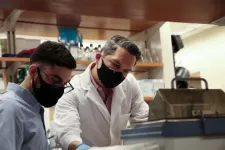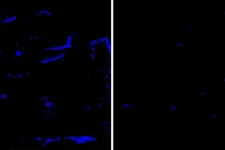(Press-News.org) CHAMPAIGN, Ill. -- Researchers who focus on fat know that some adipose tissue is more prone to inflammation-related comorbidities than others, but the reasons why are not well understood. Thanks to a new analytical technique, scientists are getting a clearer view of the microenvironments found within adipose tissue associated with obesity. This advance may illuminate why some adipose tissues are more prone to inflammation - leading to diseases like type 2 diabetes, cancer and cardiovascular disorders - and help direct future drug therapies to treat obesity.
In a new study, University of Illinois Urbana Champaign bioengineering professors Andrew Smith and Mark A. Anastasio, molecular and integrative physiology professor Erik Nelson and nutritional sciences professor Kelly Swanson detail the use of the new technique in mice. The results are published in the journal Science Advances.
Inflammation in adipose tissue presents itself as round complexes of inflammatory tissue called crownlike structures. Previous studies have shown that body fat that contains these structures is associated with worse outcomes of obesity and related metabolic disorders, the study reports.
Previously, researchers were confined to the use of 2D slices of tissue and traditional microscopy, limiting what researchers could learn about them.
To get a better view, the team combined a special type of microscopy that uses a 3D sheet of light rather than a beam, a fat-clearing technique that renders tissue optically transparent, and deep-learning algorithms that help process the large amount of imaging data produced.
The researchers found that the crownlike appearances that gives these structures their name are, in reality, more like 3D shells or concentric spheres surrounding an empty core, Smith said.
"Using our new technique, we can determine the crownlike structures' volume, the specific number of cells associated with them, as well as their size, geometry and distribution," Smith said.
This ability led the team to discover that obesity tends to be associated with a prevalence of rare, massive crownlike structures that are not present in the lean state.
"These very large crownlike structures are clustered together and located in the center of the tissue," Smith said. "And there is no way we could have analyzed this before using our new technique."
Smith said the research may lead to new drug therapies and new ways to evaluate patients' metabolic health.
"Right now, we know that some patients are overweight but metabolically healthy, while others are underweight and metabolically unhealthy," Smith said. "We believe that having the ability to look deep into the microenvironments with fat tissue may unlock some of the reasons why this is."
INFORMATION:
The National Institutes of Health and the Beckman Institute for Advanced
Science and Technology support this study.
Smith also is affiliated with materials science and engineering, the Carl R. Woese Institute for Genomic Biology, the Technology Entrepreneur Center and the Carle Illinois College of Medicine. Anastasio also is affiliated with electrical and computer engineering, computer science, Carle Illinois College of Medicine and the Beckman Institute.
Editor's notes:
To reach Andrew Smith, call 217-300-5638; email smi@illinois.edu.
The paper "3D microscopy and deep learning reveal the heterogeneity of crown-like
structure microenvironments in intact adipose tissue" is available from the U. of I. News Bureau.
A short-lived resurgence in the emission of ozone depleting pollutants in eastern China will not significantly delay the recovery of Earth's protective "sunscreen" layer, according to new research published Feb. 10 in Nature.
Stratospheric ozone, also known as Earth's ozone layer, helps shield us from the Sun's harmful Ultraviolet (UV) rays. Compounds like CFC-11 (Trichlorofluoromethane, also known as Freon-11), a chemical once considered safe and widely used as a refrigerant and in the production of insulation for buildings, rise to the stratosphere after emission on Earth's surface. Once in the atmosphere, CFC's are broken down by the UV light and result in the destruction of ozone molecules, both reducing stratospheric ozone concentrations globally ...
A neural network system that analyzes photographs can rank and distinguish suspicious, potentially precancerous skin lesions, which can turn into the deadly skin malignancy melanoma if not caught and removed early. The system accurately scoped out suspicious lesions from 68 patients in a manner that mostly matched tried-and-true evaluations from dermatologists. The results suggest the platform could help clinicians spot suspicious lesions during clinical visits faster and on a larger scale, potentially allowing for earlier diagnosis and treatment. Melanoma is ...
Understanding the molecular biology of brain tumors is key to prognosis and treatment said Le Bonheur Neuroscience Institute Co-Director Frederick Boop, MD, in his presentation "How Molecular Biology Impacts Clinical Practice" at the International Society for Pediatric Neurosurgery (ISPN) 2020 Virtual Meeting.
"Historically we have depended on what we see under a microscope to differentiate tumor types and determine prognosis and therapy," said Boop. "We know now that what we see doesn't necessarily predict how these tumors are going to behave."
Physicians are able to send a piece of a child's tumor to FoundationOne, an FDA-approved tissue-based broad companion diagnostic (CDx) for solid tumors, which provides the genomic alterations of that particular tumor. ...
A new UBC Okanagan study finds children not only reap the benefits of working with therapy dogs-they enjoy it too.
"Dog lovers often have an assumption that canine-assisted interventions are going to be effective because other people are going to love dogs," says Nicole Harris, who conducted this research while a master's student in the School of Education. "While we do frequently see children improve in therapy dog programs, we didn't have data to support that they enjoyed the time as well."
Harris was the lead researcher in the study that explored how children reacted while participating in a social skill-training program with therapy dogs.
The research saw 22 children from the Okanagan Boys and Girls ...
Resistance to tangle formation may help preserve memory
SuperAgers have fewer tangles than normally aging individuals
Future research to see how SuperAgers are protected
CHICAGO - A new Northwestern Medicine study showed cognitive SuperAgers have resistance to the development of fibrous tangles in a brain region related to memory and which are known to be markers of Alzheimer's disease.
The tangles are made of the tau protein which forms structures that transport nutrients within the nerve cell. These tangles disrupt the cell's transport system, ...
Nearly a half-million people a year die from sudden cardiac death (SCD) in the U.S. -- the result of malfunctions in the heart's electrical system.
A leading cause of SCD in young athletes is arrhythmogenic cardiomyopathy (ACM), a genetic disease in which healthy heart muscle is replaced over time by scar tissue (fibrosis) and fat.
Stephen Chelko, an assistant professor of biomedical sciences at the Florida State University College of Medicine, has developed a better understanding of the pathological characteristics behind the disease, as well as promising avenues for ...
The trial found that using sensor-based asthma inhalers may improve control of the condition and improve the quality of life for caregivers.
Greatest gains were among non-Hispanic Black participants, who experience more frequent and severe asthma than other groups.
Based on the study results, this asthma intervention should be considered for use by primary care, allergy and pulmonary care providers, to help engage diverse populations of pediatric asthma patients and their caregivers.
CHICAGO (February 17, 2021) -- Sensor-based inhalers integrated into health care providers' clinical workflows may help improve medication adherence and support children with asthma - and their families - to more effectively manage this condition, according ...
Numerous studies have shown that trained dogs can detect many kinds of disease -- including lung, breast, ovarian, bladder, and prostate cancers, and possibly Covid-19 -- simply through smell. In some cases, involving prostate cancer for example, the dogs had a 99 percent success rate in detecting the disease by sniffing patients' urine samples.
But it takes time to train such dogs, and their availability and time is limited. Scientists have been hunting for ways of automating the amazing olfactory capabilities of the canine nose and brain, in a compact device. Now, a team of researchers at MIT and other institutions has come up with a system that can detect the chemical and microbial content of an air sample with ...
As people age, a normal brain protein known as amyloid beta often starts to collect into harmful amyloid plaques in the brain. Such plaques can be the first step on the path to Alzheimer's dementia. When they form around blood vessels in the brain, a condition known as cerebral amyloid angiopathy, the plaques also raise the risk of strokes.
Several antibodies that target amyloid plaques have been studied as experimental treatments for Alzheimer's disease. Such antibodies also may have the potential to treat cerebral amyloid angiopathy, although they haven't yet been evaluated in clinical trials. ...
An international team led by researchers at the Centre for Palaeogenetics in Stockholm has sequenced DNA recovered from mammoth remains that are up to 1.2 million years old. The analyses show that the Columbian mammoth that inhabited North America during the last ice age was a hybrid between the woolly mammoth and a previously unknown genetic lineage of mammoth. In addition, the study provides new insights into when and how fast mammoths became adapted to cold climate. These findings are published today in Nature.
Around one million years ago there were no woolly or Columbian mammoths, as they had not yet evolved. This was the time of their predecessor, the ...





